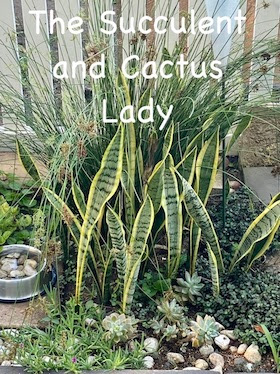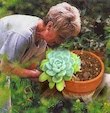Read what
"Random Harvest Nursery" has to say about this...
.
.
Where the light changes, is the best place for your succulent and
rock garden. It does not matter if it is a dry and problematic area.
.
The creation of that special place is a labour of love, because
creating mood and feeling in a garden is the same as weaving a tapestry
of colours. It takes a lot of patience and planning, but don’t let that
put you off.
.
If your space is against a wall, you could paint a desert scene that
flows into your bed, especially if your rockery is too small to plant a
large Aloe.
.
Then, taking your time, gradually release your creative genius by adding
soil and doing some earth shaping to help fashion different shadows and
light, that will add drama to architectural plants. Create miniature
landscape features like rocky canyons, outcrops and a dry river bed.
Have fun by copying a typical dry river bed in nature.
.
Include debris such as water smoothed pebbles, seeds that may have
been carried along an irregular flash flood, driftwood, grass lodged
behind an occasional rock, and dried grasses and reeds etc.
The driftwood will help to encourage soil organisms and enhance your
plants. You could even use different coloured sands to complete the
picture.
.

A little water is essential for the insects, birds and lizards that
will be drawn to the living, evolving eco-system. Make sure to allow for
a little seepage, alternatively a small grindstone shaped rock with a
dripper is sufficient. Space permitting, you could even create a small
pool backed up against a shaded rocky area in your dry riverbed.
.
Rocks and gravel come next, cultivating this habitat for plants, wildlife and organisms.

When choosing rocks and gravel they should have similar harmonious colours that will blend naturally together.
.
Creating a natural cobblestone, or rock pathway through your
succulent bed, will enable you to stroll through and get a closer look
at your creation. A stone seat, built to look like a stone wall, or a
dry stone wall or gabion with plants growing out of the spaces between
the rocks completes the picture.
.
Succulents need healthy, well-drained soil to which compost and organic fertilizer have been added.
.
When you have done the planting, mulch the area with gravel,
woodchips, bark, leaves, or other organic material; thereafter mulch the
bed with a thin layer at least once a year, but twice is better to keep
the soil healthy.
.
When deciding what to plant where, take the colours, shapes and
textures of the leaves and stems, as well as the overall character of
the plants, into account.
.
When planting, think of their natural habitat, Lithops spp. (Stone
Plants) that grow so cryptically take on the appearance of the gravel in
which they grow. Only when they burst forth in colourful, glistening
bloom are they highly visible to both us and their pollinators.
.
When placing your plants stand back and keep checking if they have
been placed correctly. Start with feature plants or “star performers”
such as large Aloes. Rocks should look completely natural.
.

Place
bulbs such as Haemanthus humilis (Rabbit’s ears), strategically under
rocks and growing from crevasses. If at the end you have made a mistake,
remember that succulents transplant very successfully and you can
easily move them.
.
Include other non-succulent species of plant to complete the picture.
Try to stick to those that would be found growing naturally near to the
succulents that you have used, or at least have similar water and sun
requirements.
.
Use grasses sparingly as they can overshadow other plants. Include a
few Tulbaghia violacea (Wild Garlic) to help with pest control.
.
The bold lines and often stocky shapes of succulents contrast very
well or are shown off with striking effect when planted with softer
plants such as some annuals or plants with small leaves and dainty
flowers.
.
Last but not least, sow a scatter pack of Namaqualand Daisies for spring-time splendour in and around your succulents.
.




























